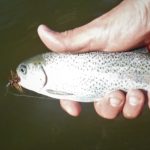
A bead head added to any pattern, including the popular Woolly Bugger, works well on getting the offering down to stocked trout as they wise up in their new environs. Simonson Photo.
By Nick Simonson
Stocked trout don’t take long to acclimate to their surroundings.
Within a week or two of the recent dumps of rainbows and browns across the state, these fish spread out and stalk the water column for just about anything edible. Whether that’s the first rising midge populations of the year, small nymphs on the bottom, or other prey items, trout find most of what they need below the surface. On those still evenings early on as they pick off rising insects, my all means, have a few dry flies at the ready for some fun surface action; but in most cases, getting down into the water column is important in upping an angler’s catch rate on the long rod when fishing prairie impoundments.
Wrap It Up
The first option in getting down to the business of catching trout is to utilize weighted flies. The addition of a few coils of weighted wire when tying up a fly pattern will help it sink quicker after splashdown and get in front of trout where they are feeding.
In lead and non-toxic alternatives, these coils can be easily wrapped along the hook shank when putting favorite patterns together at the vise and can be seamlessly worked into a fly. In diameters as small as .01 inches, the addition of these wraps can be used to tack on additional weight without bulking up a fly, though the latter can be accomplished to make certain patterns look more robust without the addition of other materials as well.
For a more subtle and natural look, weighted wire can be used on nymphs, such as the Pheasant Tail Nymph, or popular streamers like Woolly Buggers, without changing their standard profiles.
Get a Bead On It
Another way to add weight, and some fish-catching attraction, is through the use of a bead head on any nymph or streamer pattern.

Over the last two decades, the expansion of not only the varieties and colors of beads, but also the materials comprising them, have changed greatly to the advantage of anglers. Where once brass and copper were the only colored beads fly tiers had at their disposal, now multi-hued beads and even candy-painted options that seem to change color with the angle at which the light hits them give trout anglers many bright ways to accent their flies while adding the weight that gets the offering into the strike zone. Additionally, the viability and mass-production of tungsten beads has helped provide a head that helps bring a pattern down faster than lead for those still water applications, but also in fast-moving streams.
Add a bead of any sort for more weight and more flash to catch the attention of trout cruising in the water column.
Lined Up
When pattern adjustments with wire and beads aren’t an option or simply aren’t wanted, the line is the next best alternative for getting offerings in front of hungry rainbows and browns in a lake setting.
Utilizing a sinking line, designated as Type 3 or greater, anglers can quickly get down in deeper water – such as mine pits that are stocked with trout, or deeper stretches of impoundments – to find the fish, especially when things warm up and they seek cooler reaches to survive. While each brand and variety is different, the box that comes with the line will often provide the rate of sink (usually in inches-per-second) to help provide an idea as to how deep one can expect to be after a five or ten count following the cast.
Utilizing weighted flies and bead head patterns helps pull a fly down under the surface, and a sinking line will take things even further when trout are much deeper.
Utilize some or all of these options as trout hit area waters and start staking out their spaces in the depths and get on down to them to increase hook ups with fast action on the fly rod for prairie trout this spring.
